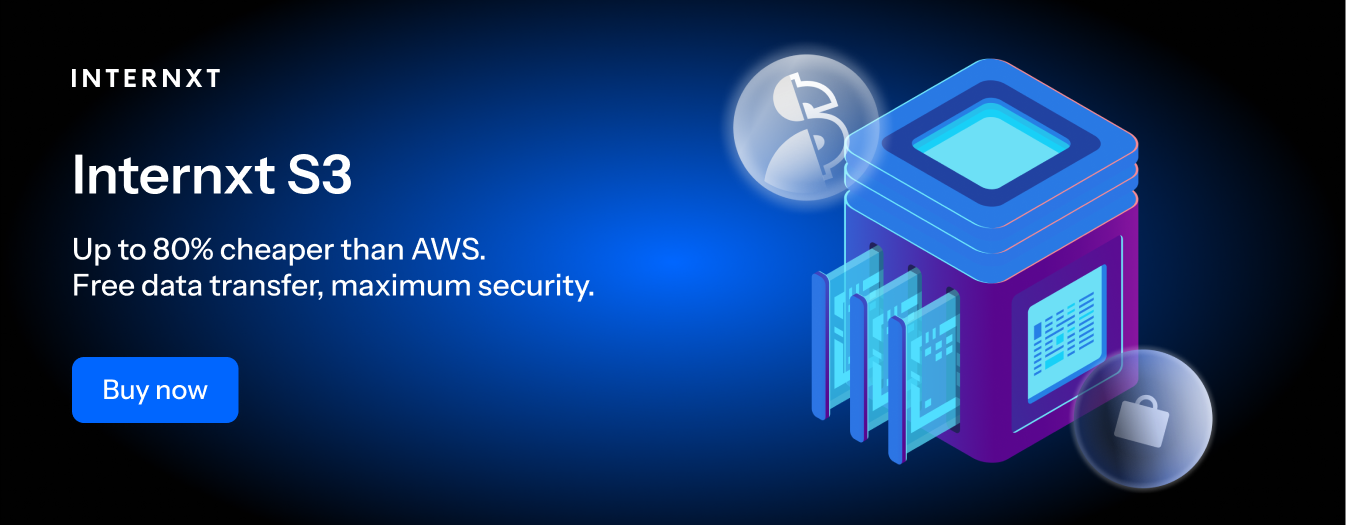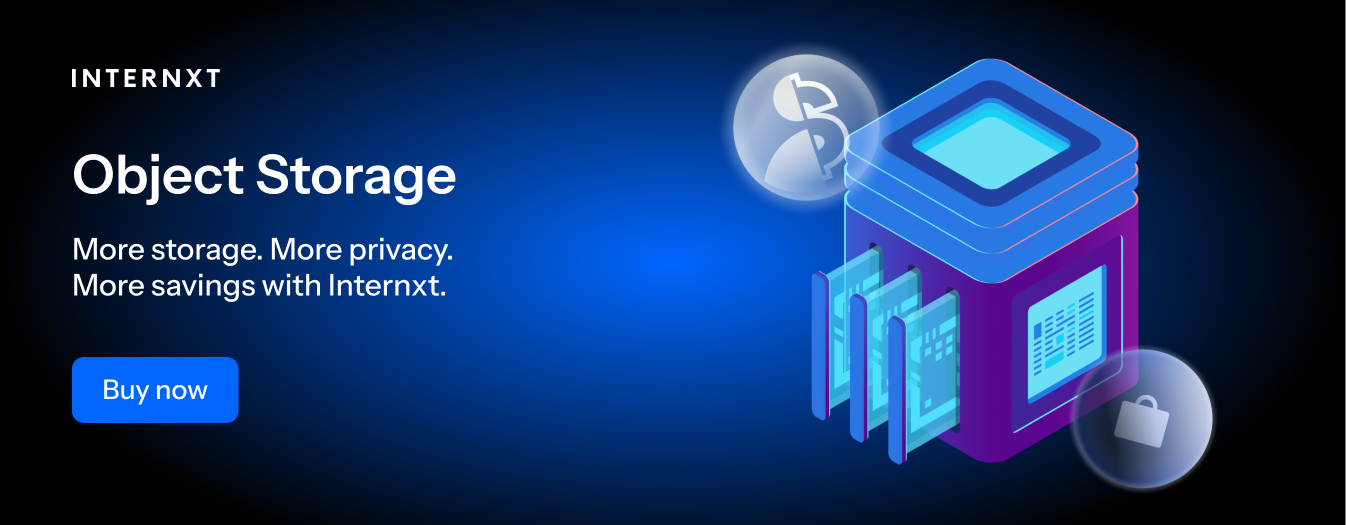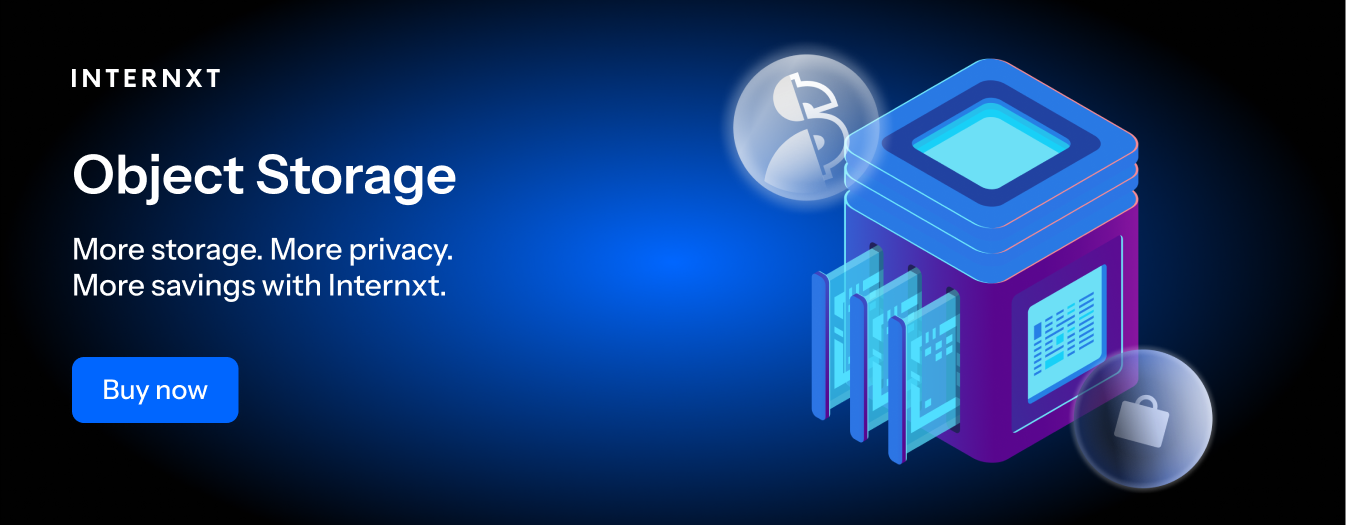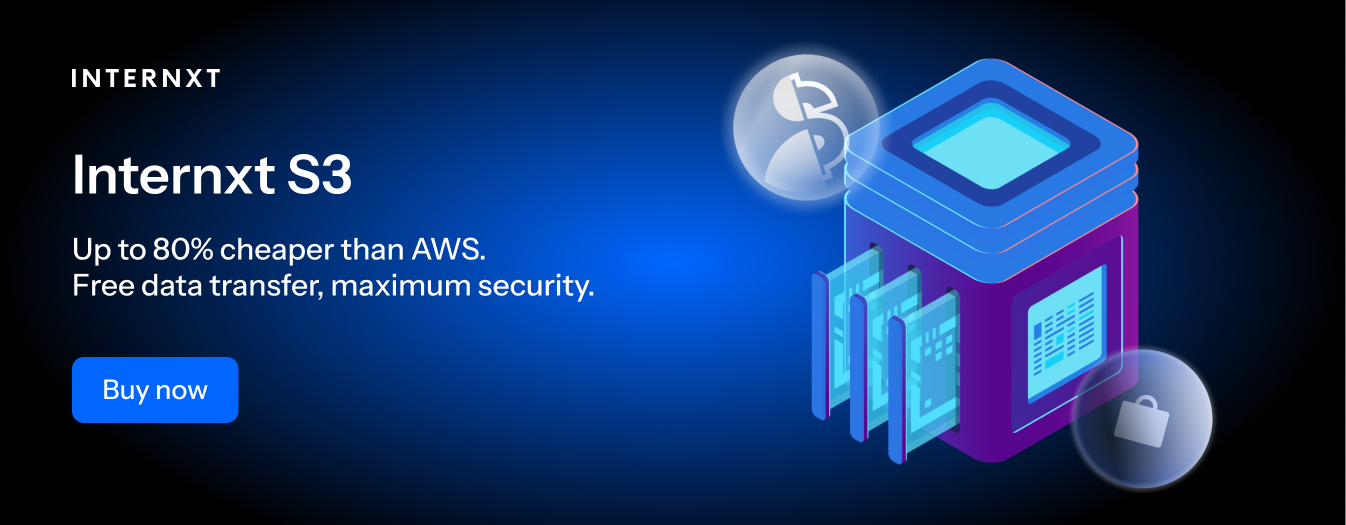What Are Cloud Egress Fees and How To Avoid Them

Managing a self-hosted cloud infrastructure can be a complex and demanding task, which is why we pay for the privilege of companies to do this for us.
Thanks to the range of options we have available, we can no move our data from the cloud quickly and easily, but there is one potential boundary of this, egress fees.
Egress fees are what you have to pay to move your data from out the your cloud provider to another data center. These fees are only a few cents per GB, but the more storage, and the more often you extract data, it could add thousands to your monthly cloud bill without you even knowing.
For this reason, we will cover what egress fees are, AWS egress fees, and the new changes from the European Data Act that will help migrate your data from AWS for free.
We will also see how Internxt S3 object storage offers an alternative to the big three of cloud storage, Google, Microsoft, and Amazon, with its cloud object storage, which has no additional fees for data transfers, potentially saving you 80% when compared to AWS.
Table of content
- What are egress fees?
- How do cloud egress fees work?
- Why do companies charge cloud egress fees?
- How much are AWS egress fees?
- How to reduce the cost of egress fees
- Pay zero egress fees with Internxt S3
What are egress fees?
In simple terms, cloud egress fees are charges from your cloud provider for transferring or moving data. This can be from data centers, private or virtual networks, or to an external environment.
In the cloud, egress fees may be charged whenever data flows out of the same center, between availability zones, or when it’s transferred to another cloud region. Whereas cloud providers don’t charge you for uploading or storing files outside the initial subscription cost, they can charge you for moving data out of their system.
It’s important to have a thorough understanding of egress fees before signing up to a cloud service, as they can significantly impact your budget if you transfer data often, and can sometimes lead to vendor lock-in, which can impact your future cloud management plans.
What’s the difference between egress and ingress fees?
When searching cloud storage pricing, you may also see ingress fees included in S3 storage costs.
The term ingress means data that enters a system. For example, when you upload files to the cloud, this is ingressing data. In contrast, downloading files is egressing data from a service or center.
The S3 storage companies, AWS, Azure, and Google Cloud, don’t typically charge you for data ingressing because they want to make it easy and cheap for you to start using their service by bringing your data in. In some cases, though, you may see some API charges, depending on the pricing model you chose.
Egress costs, on the other hand, more often than not, come with additional charges for moving your data that you have uploaded to the provider. AWS egress fees, for example, charge you extra for moving your data between different environments, but they do have a monthly free limit of 100GB.
How do cloud egress fees work?
When data is transferred from one environment to another, egress fees are charged. The cost can vary, but moving data from one region to another is much cheaper than transferring it between continents or another cloud provider.

Most egress fees are charged per gigabyte (GB) or terabyte (TB) basis, so obviously, the more data you need to move, the higher the cost. However, some cloud providers may include a free amount of egress data per month, and you will then be charged if you go over that limit.
Why do companies charge cloud egress fees?
Cloud storage providers must pay heavy costs to maintain and provide a reliable and secure service within their cloud infrasturcture. These costs include electricity, maintenance, IT staff, data cooling, bandwidth, internet infrastructure, and much more.
All of this comes at a huge cost for the cloud provider, so they have to find a way to make this service profitable, which is where egress fees come in. Because cloud businesses initially don’t charge for uploading data to the cloud to attract customers, they get their main customer base from this idea.
However, once your data is stored there, some providers want to lock you into their service, so by charging you extra to move data out of the environment, you’re more likely to keep it with the original service you signed up for.
As a result, egress fees may or may not represent a significant portion of your cloud storage budget if you rely heavily on data transfers across multiple environments.
How much are AWS egress fees?
AWS egress fees will soon change in response to the European Data Act, which was announced in January to promote fair competition and prevent vendor lock-in. This change means customers can migrate their cloud storage from one infrastructure to another without worrying about costs.
However, this change only applies when permanently moving large amounts of data off AWS.
Google Cloud was the first to eliminate egress fees to compete against the Azure and AWS egress fees model.
However, with AWS, there are still some steps you have to take if you want to migrate your data off the platform.
To do this and avoid AWS egress fees, you have to take the following steps:
- Contact AWS support and wait for approval to migrate your data.
- Once approved, you will be given the sufficient number of credits to complete your migration.
- These credits are valid for 60 days, and you will be expected to migrate all your data before this period is over.
AWS state that they will analyze each request thoroughly to avoid users from abusing the offer simply to avoid the AWS egress fees it charges for large-scale data transfers.

AWS transfer pricing
AWS egress fees are available on their website, and for more information, you can contact their sales representative.
Here are the current fees AWS charge:
- Inbound (ingress) traffic from the internet is free.
- Outbound (egress) traffic to the internet is chargeable: $0.08–$0.12 per GB after the first 100 GB per month, which is free under the AWS Free Tier.
- Inter-region data transfer (between AWS regions): $0.09 per GB for outbound traffic.
- Intra-region transfer across Availability Zones (AZs): $0.01 per GB for each of the four flows (request/response in/out).
- Same-AZ transfers are usually free.
Based on these cloud egress fees, you can expect to pay the following costs for migrating 10 and 25TB of data.
| Scenario | 10 TB | 25 TB |
|---|---|---|
| Outbound to Internet | $1,014 | $2,550 |
| Inter-region Transfer | $921.60 | $2,304 |
| Intra-region AZ Transfer (4-way) | $409.60 | $1,024 |
| Same-AZ Transfer | Free | Free |
With Internxt's object storage however, all data transfer is included in your subscription, no matter the amount of data ayou need to extract, whether it's 25TB or more, you won't pay anything.
How to reduce the cost of egress fees
Use the free tier
As most cloud storage comes with free storage plans, or, in this case, up to 100GB of free data transfers, you can use this to your benefit if you don’t need to store large amounts of data. It can also be beneficial if you need to extract a few hundred gigabytes of data occasionally, but be aware that costs can soon add up if you do this often.

Work with a consulting company
Many consulting companies can offer advice and strategies to reduce your cloud egress fees significantly. They specialize in optimizing your cloud infrastructure by analyzing traffic, improving strategies with CDNs (which we mention next), and avoiding unnecessary data transfers.
They can also plan for future costs and even negotiate better pricing with major providers like AWS to get you the best deal to meet your needs and budget.
Use a Content Delivery Network (CDN)
A content delivery network or CDN can help your company lower egress fees by caching data on edge servers. When a user requests data, it is pulled from a CDN server rather from AWS, Azure, Google Cloud, etc.
By using a CDN server to extract data, you won’t be charged any egress fees, which can save you money in the long term.
Choose the right pricing tier
Lower-priced tiers, such as cold storage models, may seem attractive due to their lower costs compared to hot cloud storage models.
Keep in mind that cold storage is cheaper because it’s generally used to store data that doesn’t need to be accessed frequently or quickly, so people choose this model for long-term storage. If you want to extract data, it could be more costly, take significantly longer than hot storage, and may cost you more in the long run.
Keep data in the same region
Transferring data between different regions or continents will quickly increase storage costs. To avoid unnecessary egress fees, keep your applications, services, and storage within the same cloud region.
Shop around
Aside from the top three cloud providers, there are many other options for backing up, storing, and managing your data in the cloud. Most of these, such as Internxt S3, don’t have any egress fees and offer other services that focus on external backups, such as IDrive
By shopping around, you can pick the right storage model for you, with easy-to-understand pricing models to help you stay on budget and avoid vendor lock-in.

Pay zero egress fees with Internxt S3
Internxt S3 has everything you need to manage the costs of your cloud storage needs with its cloud object storage service. It’s a 100% hot cloud storage platform, meaning you can access data instantly, and whenever you need it.
Best of all, no matter how much storage you need, or how much you need to transfer, you will pay a fixed amount of €7/TB/month and you won’t be charged any extra for transfer fees. With Internxt, you only pay for the storage you use, and you can upgrade or downgrade storage whenever you need and migrate data as much, or as little, as you need.
Aside from offering affordable and scalable cloud storage, Internxt S3 comes with advanced end-to-end encryption and customer-provided encryption keys to give you control over the security of your data.
Our object storage also includes built-in redundancy of your files to ensure your files are backed up and recoverable to align with our GDPR compliance standards.
To find out how Internxt object storage can benefit your organization, visit our website and fill out our contact form to get in contact with our dedicated sales team who will support you in getting the best storage for your enterprise.

